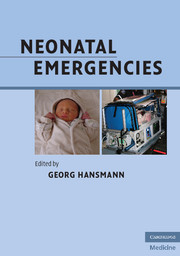Book contents
- Frontmatter
- Contents
- List of contributors
- Foreword (1)
- Foreword (2)
- Preface
- Acknowledgments
- Section 1 Organization of neonatal transport
- Section 2 Basics in cardiopulmonary resuscitation of newborn infants
- Section 3 Classic and rare scenarios in the neonatal period
- Management of healthy, term newborn infants (vaginal delivery, cesarean section, vacuum extraction, forceps delivery)
- Management of preterm and moderately depressed term newborn infants with a birth weight ≥1500 g
- Management of very preterm newborn infants (VLBW, ELBW)
- Twin–twin (feto–fetal) transfusion syndrome
- An apparently trivial call from the term baby nursery
- Out of hospital birth
- Hypoglycemia
- Meconium aspiration
- Chorioamnionitis and early-onset sepsis in the newborn infant
- Perinatal hemorrhage
- Perinatal hypoxia-ischemia
- Cerebral seizures
- Infants born to mothers on psychoactive substances
- Prenatal and postnatal arrhythmias
- Critical congenital cardiovascular defects
- Patent ductus arteriosus of the preterm infant
- Persistent pulmonary hypertension of the newborn (PPHN)
- Congenital diaphragmatic hernia
- Pneumothorax
- Congenital cystic adenomatoid malformation of the lung (CAM, CCAM)
- Chylothorax
- Hemolytic disease of the newborn
- Hydrops fetalis
- Choanal atresia
- Esophageal atresia
- Gastrointestinal obstruction
- Necrotizing enterocolitis (NEC)
- Omphalocele and gastroschisis
- Neural tube defects
- Cleft palate
- Birth trauma: brachial plexus palsy, facial nerve palsy, clavicular fracture, skull fracture, intracranial and subperiosteal hemorrhage (cephalohematoma)
- Sudden infant death syndrome (SIDS)
- Questions for review
- References (Section 3)
- Section 4 Transport
- Section 5 Appendix
- Index
- Plate section
Management of very preterm newborn infants (VLBW, ELBW)
from Section 3 - Classic and rare scenarios in the neonatal period
Published online by Cambridge University Press: 05 March 2012
- Frontmatter
- Contents
- List of contributors
- Foreword (1)
- Foreword (2)
- Preface
- Acknowledgments
- Section 1 Organization of neonatal transport
- Section 2 Basics in cardiopulmonary resuscitation of newborn infants
- Section 3 Classic and rare scenarios in the neonatal period
- Management of healthy, term newborn infants (vaginal delivery, cesarean section, vacuum extraction, forceps delivery)
- Management of preterm and moderately depressed term newborn infants with a birth weight ≥1500 g
- Management of very preterm newborn infants (VLBW, ELBW)
- Twin–twin (feto–fetal) transfusion syndrome
- An apparently trivial call from the term baby nursery
- Out of hospital birth
- Hypoglycemia
- Meconium aspiration
- Chorioamnionitis and early-onset sepsis in the newborn infant
- Perinatal hemorrhage
- Perinatal hypoxia-ischemia
- Cerebral seizures
- Infants born to mothers on psychoactive substances
- Prenatal and postnatal arrhythmias
- Critical congenital cardiovascular defects
- Patent ductus arteriosus of the preterm infant
- Persistent pulmonary hypertension of the newborn (PPHN)
- Congenital diaphragmatic hernia
- Pneumothorax
- Congenital cystic adenomatoid malformation of the lung (CAM, CCAM)
- Chylothorax
- Hemolytic disease of the newborn
- Hydrops fetalis
- Choanal atresia
- Esophageal atresia
- Gastrointestinal obstruction
- Necrotizing enterocolitis (NEC)
- Omphalocele and gastroschisis
- Neural tube defects
- Cleft palate
- Birth trauma: brachial plexus palsy, facial nerve palsy, clavicular fracture, skull fracture, intracranial and subperiosteal hemorrhage (cephalohematoma)
- Sudden infant death syndrome (SIDS)
- Questions for review
- References (Section 3)
- Section 4 Transport
- Section 5 Appendix
- Index
- Plate section
Summary
Definition
Very low birth weight (VLBW) infants (birth weight <1500 g) and extremely low birth weight (ELBW) infants (birth weight <1000 g) constitute approximately 1.2% and 0.4% of all newborn babies in industrialized countries, respectively
Induction of fetal lung maturation by betamethasone and prenatal transfer to a perinatal level III center prior to delivery of any such tiny infant is of paramount importance. This way, the most experienced doctors and nurses available perform or supervise the initial care of very immature infants. If prenatal transport is not possible due to rapid birth progression, call the Neonatal Emergency Transport Service (NETS) at the earliest available opportunity.
Many details of the initial care of very preterm infants are controversial. Health care providers, while striving for the best evidence available, may follow locally established guidelines to benefit from the experience in a particular environment and to ensure a team approach
Questions prior to delivery
Prenatal transfer allows the health care team to discuss treatment options with expectant parents before delivery in cases of borderline viability (see Chapter “Ethics in neonatal intensive care,” pp. 184–90).
Is there a reliable estimate of gestational age?
What is the estimated birth weight?
Has fetal lung maturation been induced (e.g., betamethasone: how many doses and how many hours prior to delivery)?
Are there signs of fetal distress? for example, fetal tachycardia or bradycardia
Are there signs of perinatal infection (maternal fever, CRP, GBS status, etc.)?
Preparations in the delivery room
Temperature
Increase room temperature to 25–30°C if possible
Turn on radiant heaters
Keep doors closed
Have prewarmed cotton towels or food-grade, heat-resistant plastic wrapping or bags ready
- Type
- Chapter
- Information
- Neonatal Emergencies , pp. 231 - 239Publisher: Cambridge University PressPrint publication year: 2009



